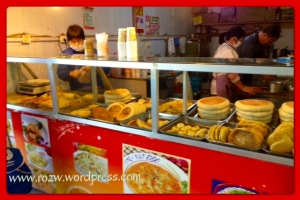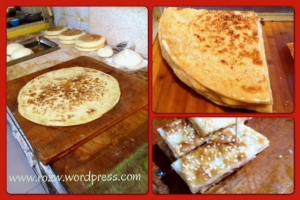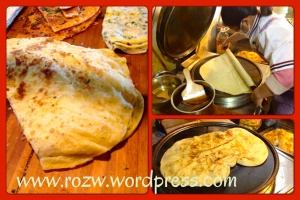BREAD FEEDS THE WORLD: BREAD MAKING IN CHINA
Every country throughout the world has their own typical or cultural bread. China is no exception with their mantou and baozi, which are rolls of dough steamed in stacked covered bamboo or (now) metal baskets at boiling temperature, sometimes being stuffed with meats or vegetable combinations. But perhaps a fairly unknown but interesting, tasty and most-like Western bread is Guandu Baba.
Baba is a yeast bread, made in my local neighbourhood market near Guandu Ancient Town in a 40 meter square bake shop. But it’s not your traditional Western loaf, cut into slices, but a 10-15 centimetre round, so delicious with a wonderful texture like some Western breads. Since finding Baba, the baking couple have become my friends, sharing our creations in bread making and our little secrets (even though the language barrier is great, we still enjoy our short conversations). When I asked to watch them and know more about this bread process, they obliged.
I have used Guandu Baba for making salty and fruit pizzas as well as my main breakfast food – cut into quarters, sliced in half through the middle, toasted in my small oven, and eaten with butter or jam or cream cheese. At this point I’d bet it’s even delicious with peanut butter.
No matter where you live in the world, if you’re a bread maker, your work starts way before your customers get their hankering for a slice of your bread or toast, and usually even before the sun comes up. My bakers, who come from DongBei in northern China, are no different. Mr. Wang Jing Zhang and Mrs. Bi Yi Min start their loaves rising at 6am and continue to bake and serve their customers until the last of their daily supply is sold – that’s usually 8pm. You could say that bread making is not an easy life. But it’s a rewarding one – as “bakers feed the world”.
It’s said that Westerners eat bread and Chinese eat rice. Of course there is much truth to that in general, however Westerners eat bread more often in loaves, whereas Chinese have just as many varieties of bread products to choose from. What starts off as basic dough, but by changing the shape or changing from wheat to rice flour, produces a huge variety of foods by mixing in or sprinkling on some spices, more or less salt or sugar, other ingredients, such as eggs, or vegetables, or adding or subtracting oil.
(I like to call them) my bakers use one small grill-type round ‘oven’ for their many varieties of bread-type foods. Interesting enough, the temperature of 150C was used for all products, only shortening or lengthening the cooking/baking time…all done without a timer, amazingly!
When asked how she learned to make these breads, Yu Min, replies, “There’s no big secret to our recipes. These are the original green foods, free from chemicals with no food additives and made with pure ingredients. They’re the ones that we’ve been eating since we were little kids.”
The baba dough consists of plain wheat flour, water, yeast and a very tiny amount of MSG. When saying this she puts her thumb and finger together to suggest a pinch! The dough is mixed and shaped into larger than fist sized discs and set aside in their warm, small shop to rise on baking sheets until about doubled in size. The baking procedure is simple. Three babas at a time are placed on bottom of the ‘oven’ – a very lightly greased surface – and using the hand, are flattened. Then the lid of the ‘oven’ is closed. The babas bake on one side for 5 minutes, then are turned with wooden tongs and cooked on the other side for another 2 minutes with the lid closed again. After much discussion about the correct name for this oven, it’s been determined that the oven is called a “Bing Cheng 饼铛”. Voila, fresh, hot, wonderful smelling Guandu Baba!
This dough is also used to make the large flat pancakes with a heavy, long rolling pin, in two flavours. More oil is added and the first pancakes come out of the oven quickly, then are sprinkled with sesame seeds on top, cut into small bits and put into a small plastic bag with a toothpick from snacking as you walk along doing your errands. There’s a lovely, crispy sesame taste to these.
The same pancake is morphed into a spicier snack, with a mixture of chilli sauce, sprinkled with green onion on the top.
The dough that’s wrapped in clear plastic is the original recipe with some oil and eggs added into the dough, and following the same procedure as above, is cooked in more oil and done very quickly.
The morning I was there, they had already made over 30 babas, many other kinds of bread products, and nice warm soya bean milk. And that was at 9:00 in the morning. During the mid day they will make another batch or two of dough and continue to bake more breads throughout the day, keeping their booth stocked with the tasty morsels that the customers have grown to love over the 6 years they have been in Kunming.
I am wondering if they’re going to expand or sell their business. Just last week, they had a woman and her son working together and the baker seemed to be teaching his sister-in-law and nephew how to do what he and his wife have been doing for so long…baking baba and traditional street snacks. It’s quite normal that with two more pairs of hands in the back, their business will improve, just as long as they don’t move or close down that will be fine…that would be a pity for all of the residents of my neighbourhood but mostly for me!
My hats off to this talented couple who, like so many others in the same shoes all over China, work incredibly long hours in cramped quarters with recipes passed down from generations using simple utensils and equipment to feed the masses with ever tasty and predicable breads!
Posted on Monday, November 25, 2013, in Chinese Cookbook, Letters From China, Recipes, Travel, Uncategorized and tagged bread, China, Chinese Bread, Chinese cooking, Chinese cuisine, Chinese food, cookbook, cooking, food, Guandu Baba, how to cook Chinese Food, Mantou, recipes, Roz Weitzman's World of Chinese Comfort Food, Yunnan Cuisine, Yunnan Province. Bookmark the permalink. Leave a comment.










Leave a comment
Comments 0